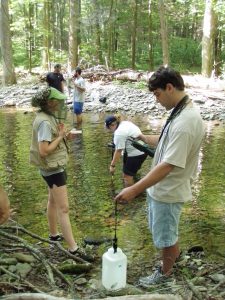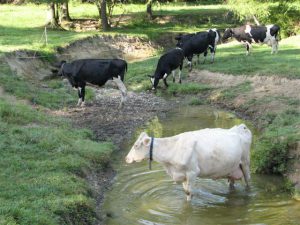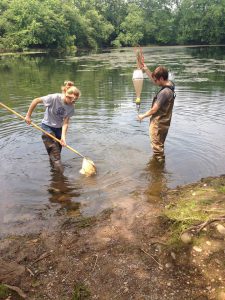There are a lot of different measures of water quality. Last week we shared information on three and this week we’re going to share three more parameters. If you’re interested in learning more, the United States Geological Survey (USGS) has a great website called “Water Science School.”
So, here’s more information about dissolved oxygen, nutrients, and coliform…..
Dissolved Oxygen
Dissolved oxygen is the oxygen available in the water for the aquatic organisms to breathe. Oxygen is diffused into the water from air, by fast moving waters, and as a byproduct of photosynthesis. The more
the water moves, the higher the oxygen level will be.
Also, the cooler the water is, the more oxygen it can hold. Trees, plants, and shrubs along a stream bank provide shade to the stream. This helps the water stay cooler, which means it can hold more dissolved oxygen.
Although good oxygen levels are often challenging to pinpoint since oxygen levels fluctuate naturally between day and night, generally good oxygen levels fall around 7 mg/L or higher.
If oxygen levels remain below 1 or 2 milligrams per liter of water for just a few hours, many fish can die.
Nutrients – Nitrogen and Phosphorus
Nitrogen is found naturally in the environment and is an essential nutrient to plant life. Nitrate is the most significant form of Nitrogen in terms of water quality. Nitrates are used in fertilizers for lawns and agricultural crops. Additionally, nitrates can be found in municipal and animal wastes.
 High concentrations of nitrates cause an increase in water plants, algae, and planktons. The more plants there are in the water, the more oxygen they’ll consume as they grow. This can lead to oxygen depletion.
High concentrations of nitrates cause an increase in water plants, algae, and planktons. The more plants there are in the water, the more oxygen they’ll consume as they grow. This can lead to oxygen depletion.
Generally, healthy nitrogen levels should be around 0.5 milligrams per liter of water (0.5 mg/L) or less.
Phosphorus, like nitrogen, is a nutrient naturally present in the environment. But when found in high concentrations, phosphorus can disrupt the natural ecosystem by increasing the growth of algae, water plants, and plankton which provide food for fish. Again, the more plants there are in the water, the more oxygen they’ll consume as they grow. This can lead to oxygen depletion.
Some sources of high phosphorus concentrations include detergents and municipal fertilizer run-off. For human beings, consuming too much phosphorus can lead to digestive problems.
Healthy phosphorus levels generally fall below 0.05 mg/L.
When there is an excess of these nutrients in the water, a condition known as “eutrophication” occurs. Eutrophication means that there is an increase in chemical nutrients to a degree which is unhealthy for the body of water. When an excess of nutrients enters the waterway, algae, aquatic plants, and plankton will grow wildly. The plants will then choke up the waterway and use up large amounts of oxygen. This rapid growth of aquatic plants will eventually die and, with its decay, uses up more oxygen—ultimately lowering dissolved oxygen levels in the water.
Coliform Bacteria
Coliform bacteria are present in the digestive tracts and, consequently, fecal matter of all animals, including humans. Coliforms appear naturally in low amounts in low-flowing water. High  concentrations, however, are often signs of municipal wastewater, dumping or septic contamination.
concentrations, however, are often signs of municipal wastewater, dumping or septic contamination.
Coliform bacteria are organisms. They can carry waterborne diseases or viruses, being a potential health risk for human beings.
For primary contact with the water (i.e. swimming) the coliform concentration cannot exceed 200 coliforms per 100 milliliters (ml) and primary drinking water must report 0 coliforms per 100 ml. Natural contamination usually lies under the 200 coliforms per 100 ml level but if it is over this level there is a much greater chance that pathogenic (disease causing) organisms are present.
This summer several public swimming areas had to be closed due to high coliform bacteria levels. The managers of those areas continued to monitor the coliform levels and followed the protocols for when and how to re-open the swimming areas.

